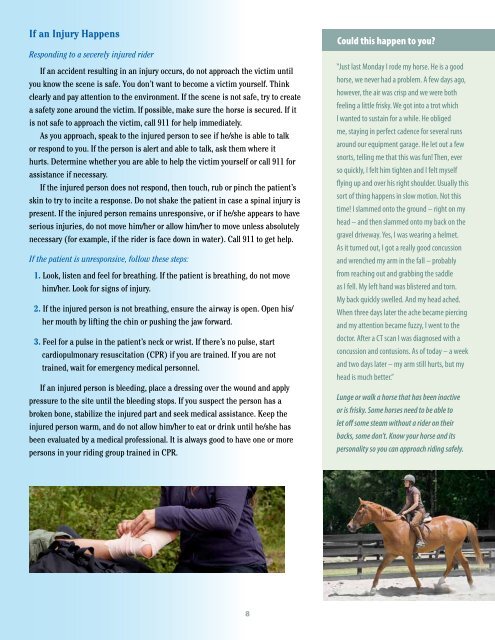Horse Related Injury Brochure - Alberta Equestrian Federation
Horse Related Injury Brochure - Alberta Equestrian Federation
Horse Related Injury Brochure - Alberta Equestrian Federation
You also want an ePaper? Increase the reach of your titles
YUMPU automatically turns print PDFs into web optimized ePapers that Google loves.
If an <strong>Injury</strong> Happens<br />
Responding to a severely injured rider<br />
If an accident resulting in an injury occurs, do not approach the victim until<br />
you know the scene is safe. You don’t want to become a victim yourself. Think<br />
clearly and pay attention to the environment. If the scene is not safe, try to create<br />
a safety zone around the victim. If possible, make sure the horse is secured. If it<br />
is not safe to approach the victim, call 911 for help immediately.<br />
As you approach, speak to the injured person to see if he/she is able to talk<br />
or respond to you. If the person is alert and able to talk, ask them where it<br />
hurts. Determine whether you are able to help the victim yourself or call 911 for<br />
assistance if necessary.<br />
If the injured person does not respond, then touch, rub or pinch the patient’s<br />
skin to try to incite a response. Do not shake the patient in case a spinal injury is<br />
present. If the injured person remains unresponsive, or if he/she appears to have<br />
serious injuries, do not move him/her or allow him/her to move unless absolutely<br />
necessary (for example, if the rider is face down in water). Call 911 to get help.<br />
If the patient is unresponsive, follow these steps:<br />
1. Look, listen and feel for breathing. If the patient is breathing, do not move<br />
him/her. Look for signs of injury.<br />
2. If the injured person is not breathing, ensure the airway is open. Open his/<br />
her mouth by lifting the chin or pushing the jaw forward.<br />
3. Feel for a pulse in the patient’s neck or wrist. If there’s no pulse, start<br />
cardiopulmonary resuscitation (CPR) if you are trained. If you are not<br />
trained, wait for emergency medical personnel.<br />
If an injured person is bleeding, place a dressing over the wound and apply<br />
pressure to the site until the bleeding stops. If you suspect the person has a<br />
broken bone, stabilize the injured part and seek medical assistance. Keep the<br />
injured person warm, and do not allow him/her to eat or drink until he/she has<br />
been evaluated by a medical professional. It is always good to have one or more<br />
persons in your riding group trained in CPR.<br />
Could this happen to you<br />
Just last Monday I rode my horse. He is a good<br />
horse, we never had a problem. A few days ago,<br />
however, the air was crisp and we were both<br />
feeling a little frisky. We got into a trot which<br />
I wanted to sustain for a while. He obliged<br />
me, staying in perfect cadence for several runs<br />
around our equipment garage. He let out a few<br />
snorts, telling me that this was fun! Then, ever<br />
so quickly, I felt him tighten and I felt myself<br />
flying up and over his right shoulder. Usually this<br />
sort of thing happens in slow motion. Not this<br />
time! I slammed onto the ground – right on my<br />
head – and then slammed onto my back on the<br />
gravel driveway. Yes, I was wearing a helmet.<br />
As it turned out, I got a really good concussion<br />
and wrenched my arm in the fall – probably<br />
from reaching out and grabbing the saddle<br />
as I fell. My left hand was blistered and torn.<br />
My back quickly swelled. And my head ached.<br />
When three days later the ache became piercing<br />
and my attention became fuzzy, I went to the<br />
doctor. After a CT scan I was diagnosed with a<br />
concussion and contusions. As of today – a week<br />
and two days later – my arm still hurts, but my<br />
head is much better.”<br />
Lunge or walk a horse that has been inactive<br />
or is frisky. Some horses need to be able to<br />
let off some steam without a rider on their<br />
backs, some don’t. Know your horse and its<br />
personality so you can approach riding safely.<br />
(Placeholder for brain<br />
imaging depicting<br />
concussion)<br />
8


